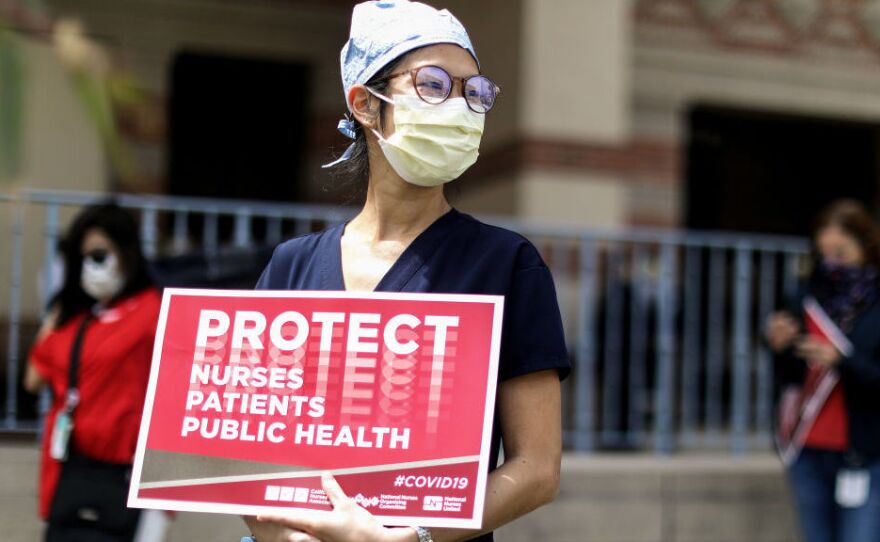The coronavirus continues to batter the U.S. health care workforce.
More than 60,000 health care workers have been infected and close to 300 have died from COVID-19, according to new data from the Centers for Disease Control and Prevention.
The numbers mark a staggering increase from six weeks ago when the CDC first released data on coronavirus infections and deaths among nurses, doctors, pharmacists, EMTs, technicians and other medical employees. On April 15, the agency reported 27 deaths and more than 9,000 cases of infection in health care workers.
The latest tally doesn't provide a full picture of illness in this essential workforce, because only 21% of the case reports sent to the CDC included information that could help identify the patient as a health care worker. Among known health care workers, there was also missing information about how many of those people actually died.
Still, the growing number of health care workers infected by the coronavirus provides sobering evidence that many are still working in high-risk settings without reliable or adequate protection against the virus.
"It is underreported," says Zenei Cortez, president of National Nurses United (NNU), the largest union of nurses in the country.
The union has compiled its own count of more than 530 health care fatalities from COVID-19, using publicly available information like obituaries. A recent NNU survey of 23,000 nurses found that more than 80% had not yet been tested for the coronavirus.
Across the country, many nurses say they still don't have enough personal protective equipment (PPE) such as masks and gowns and are required to reuse N95 masks and other supplies — practices that were considered substandard before the pandemic. Many hospitals and nursing homes continue to operate with inadequate supplies and are rationing them.
"Everything is under lock and key. If you are going to respond to an emergency, you sometimes have to wait for someone to unlock a cabinet," Cortez says of some hospitals' PPE supplies.
Cortez cites the death of a nurse from Southern California who rushed to the bedside of a COVID-19 patient who had stopped breathing. The nurse was wearing only a surgical mask, which offers less protection against airborne infection than the closer-fitting N95 respirator mask.
"Fourteen days after that incident, she died because she contracted the virus," Cortez says. "If the PPE was readily available, she maybe could have put on the N95 mask and been prevented from getting the virus."
Cortez worries that some of these unsafe practices around infection control have become normalized in U.S. health care settings and will persist in the coming months as the country reopens.
NPR recently reported that in the spring of 2017 the Trump administration halted the final implementation of new federal regulations that would have required the health care industry to prepare for an airborne infectious disease pandemic. Consequently, there are no federal workplace rules that specifically protect health care workers from deadly airborne pathogens such as influenza, tuberculosis or the coronavirus.
"The really sad thing is not having solid numbers from many states," Pat Kane, executive director of the New York State Nurses Association, says regarding the number of COVID-19 cases and deaths among health care workers.
Early in the outbreak, Kane says, many nurses could not get tested. Her own statewide union has lost more than 30 nurses in the pandemic.
"Some of them actually died outside of the hospital, trying to recover at home," she says.
More than half of the nurses in the New York state union still report not having enough personal protective equipment.
"In some places, we still see people operating under contingency and crisis guidelines," she says.
In early May, New York Gov. Andrew Cuomo touted the results of an antibody testing survey that showed a 12% infection rate among health care workers in New York City, compared with the 20% infection rate among residents citywide.
But Kane says that lower number isn't something to celebrate.
"Our members showed up and many of them made the ultimate sacrifice," she says. "And many of them got sick. That was Round 1. We should be better informed by our experience."
As more regions in the United States reopen, the safety of health care workers needs to be a key benchmark for decision-makers, Kane says, and must include enforceable precautionary standards — not just voluntary guidelines for employers, which shift according to the amount of PPE available.
At Northwestern University, Dr. James Adams says the number of health care workers with COVID-19 dropped significantly after his hospital started requiring everyone on-site to wear masks.
Adams says closely tracking the full extent of the COVID-19 burden among health workers will be crucial as access to testing improves.
"Up to this point, we have largely not known what is going on with the workforce and this infection rate," says Adams, a professor of emergency medicine. "What we need is the confidence of health care workers, and we should track this in order to ensure their health."
Copyright 2020 NPR. To see more, visit https://www.npr.org.






